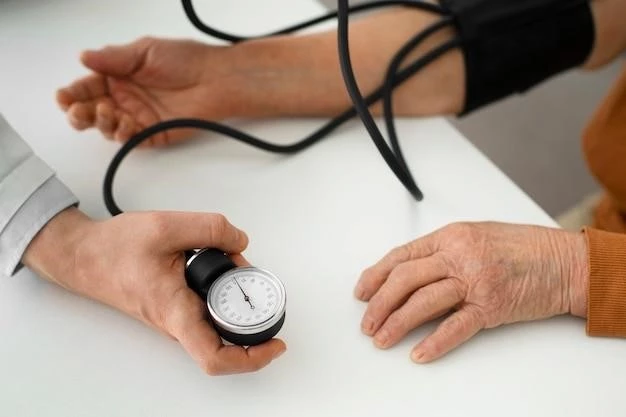Disease ⎼ Environment Associated Hypertension
Environmental factors play a crucial role in the development of hypertension. Understanding this disease in the context of the environment is essential for prevention and treatment. Explore the impact of various factors and learn how to navigate them effectively.
I. Introduction
Welcome to the comprehensive guide on environment-associated hypertension. Hypertension‚ or high blood pressure‚ is a prevalent condition worldwide. Environmental factors‚ such as pollution‚ stress‚ and lifestyle choices‚ significantly contribute to the development and exacerbation of this disease. Understanding how our surroundings impact our health is key to managing hypertension effectively. This article will delve into the various risk factors‚ treatment options‚ and preventive measures associated with environment-induced hypertension. By gaining insight into the interplay between our environment and health‚ you can take proactive steps to safeguard yourself against this common yet serious condition.
II. Understanding Hypertension
Hypertension‚ commonly known as high blood pressure‚ is a chronic medical condition characterized by elevated blood pressure levels in the arteries. This disease puts individuals at a higher risk of heart disease‚ stroke‚ and other serious health complications. Understanding hypertension involves recognizing the two key measurements – systolic and diastolic blood pressure readings. Systolic pressure measures the force when the heart beats‚ while diastolic pressure measures the force when the heart rests between beats. A blood pressure reading of 120/80 mmHg is considered normal‚ while readings exceeding 130/80 mmHg indicate hypertension. It is crucial to monitor blood pressure regularly as uncontrolled hypertension can damage blood vessels and organs over time. By comprehending the significance of blood pressure levels and the implications of hypertension on overall health‚ individuals can make informed decisions to prevent and manage this condition.
III. Risk Factors for Environment-Associated Hypertension
Several risk factors contribute to environment-associated hypertension. These include environmental pollution‚ high salt intake‚ stress‚ genetics‚ sedentary lifestyle‚ and unhealthy dietary choices. Exposure to air pollutants‚ such as particulate matter and ozone‚ can raise blood pressure levels. Consuming excessive amounts of salt can lead to fluid retention and increase blood pressure. Chronic stress triggers hormonal responses that elevate blood pressure over time. Genetic predisposition plays a role in hypertension‚ with some individuals being more susceptible to elevated blood pressure due to familial factors; Sedentary behavior and poor dietary habits‚ such as excessive sugar and saturated fat intake‚ can also heighten the risk of developing hypertension. Understanding these risk factors is essential in adopting preventive measures to mitigate the environmental impact on blood pressure levels.
IV. Environmental Factors Contributing to Hypertension
Various environmental factors significantly contribute to the development of hypertension. Air pollution‚ noise pollution‚ exposure to chemicals‚ and lack of green spaces all play a role in elevating blood pressure levels. Air pollutants like nitrogen dioxide and fine particulate matter can cause inflammation and oxidative stress in the body‚ impacting cardiovascular health. Noise pollution‚ commonly found in urban areas‚ can lead to chronic stress and disrupt sleep patterns‚ which in turn affect blood pressure regulation. Exposure to chemicals in our surroundings‚ such as pesticides or industrial pollutants‚ can also have adverse effects on blood pressure. Additionally‚ limited access to green spaces and natural environments can contribute to increased stress levels and higher blood pressure. Understanding and mitigating these environmental factors are crucial in managing and preventing hypertension induced by our surroundings.
V. Impact of Genetics on Environment-Associated Hypertension
Genetics play a significant role in environment-associated hypertension. Certain gene variations can predispose individuals to developing high blood pressure when exposed to environmental triggers. Understanding the interplay between genetic factors and environmental influences is crucial in assessing one’s susceptibility to hypertension. Genetic testing and family history evaluation can provide valuable insights into the risk of hypertension. By recognizing the genetic component of this condition‚ individuals can take proactive measures to modify environmental factors and adopt a lifestyle that promotes healthy blood pressure levels. Collaborating with healthcare professionals to address both genetic and environmental aspects of hypertension is key to effective management and prevention.
VI. Lifestyle Choices and Blood Pressure
Healthy lifestyle choices play a crucial role in maintaining optimal blood pressure levels and preventing environment-associated hypertension. A balanced diet rich in fruits‚ vegetables‚ whole grains‚ and lean proteins can support cardiovascular health. Limiting salt‚ sugar‚ and saturated fat intake can help reduce the risk of high blood pressure. Regular physical activity is essential for managing weight‚ improving heart health‚ and lowering blood pressure. Avoiding tobacco and excessive alcohol consumption are also important lifestyle measures to safeguard against hypertension. Stress management techniques like mindfulness‚ meditation‚ and yoga can help reduce anxiety and prevent spikes in blood pressure. By making positive lifestyle choices‚ individuals can proactively protect their heart health and reduce the impact of environmental factors on blood pressure.
VII. Pollution and Hypertension
Environmental pollution poses a significant risk factor for hypertension. Air pollution‚ in particular‚ is linked to elevated blood pressure levels due to the presence of harmful substances like particulate matter and nitrogen oxides in the air. Long-term exposure to polluted air can increase the risk of developing hypertension and cardiovascular diseases. Individuals living in urban areas or near industrial sites may be more susceptible to the effects of pollution on blood pressure. It is essential to minimize exposure to air pollution by staying indoors during high pollution days‚ using air purifiers‚ and supporting clean air initiatives. By advocating for cleaner environments and reducing personal exposure to pollutants‚ individuals can help mitigate the impact of pollution on hypertension and prioritize their heart health.
VIII. Salt Intake and Blood Pressure
The amount of salt consumed plays a critical role in blood pressure regulation and the development of hypertension. High salt intake can lead to fluid retention‚ increasing the volume of blood in the arteries and raising blood pressure. The recommended daily intake of salt for adults is 5 grams or less to maintain optimal blood pressure levels. It is important to be mindful of hidden salts in processed foods and sauces‚ which can contribute to exceeding daily limits; Reading food labels and choosing low-sodium alternatives can help reduce salt intake. Incorporating potassium-rich foods like fruits‚ vegetables‚ and legumes can counteract the effects of sodium on blood pressure. By monitoring and moderating salt intake‚ individuals can support healthy blood pressure levels and reduce their risk of hypertension related to excessive sodium consumption.

IX. Stress Management for Hypertension Prevention
Effective stress management is crucial for preventing hypertension in the context of environmental influences. Chronic stress can elevate blood pressure levels and contribute to the development of cardiovascular issues. Engaging in relaxation techniques such as deep breathing‚ meditation‚ and yoga can help reduce stress and promote emotional well-being. Regular physical activity‚ adequate sleep‚ and maintaining a healthy work-life balance are also vital in managing stress levels. Creating a support network‚ practicing mindfulness‚ and setting boundaries can aid in coping with stressors effectively. By prioritizing stress management strategies‚ individuals can protect their cardiovascular health‚ lower their risk of hypertension‚ and enhance their overall quality of life.
X. Importance of Exercise in Managing Hypertension
Regular exercise plays a vital role in managing hypertension influenced by environmental factors. Physical activity helps strengthen the heart‚ improve blood circulation‚ and lower blood pressure levels. Aim for at least 150 minutes of moderate-intensity exercise per week‚ such as brisk walking‚ swimming‚ or cycling. Incorporating strength training exercises twice a week can further enhance cardiovascular health. Exercise not only helps control weight but also reduces stress‚ a significant contributor to high blood pressure. Choose activities you enjoy to make physical fitness a sustainable habit; Consult with a healthcare provider before starting a new exercise routine‚ especially if you have hypertension. By making exercise a priority‚ individuals can effectively manage blood pressure and mitigate the impact of environmental influences on cardiovascular health.
XI. Role of Medication in Treating Hypertension
Medication plays a crucial role in treating hypertension exacerbated by environmental factors. Antihypertensive medications‚ including diuretics‚ beta-blockers‚ ACE inhibitors‚ and calcium channel blockers‚ are commonly prescribed to help lower blood pressure. These medications work by relaxing blood vessels‚ reducing blood volume‚ or controlling heart rate to manage hypertension effectively. It is essential to take prescribed medications as directed by healthcare professionals and attend regular follow-up appointments to monitor blood pressure levels and adjust treatment‚ if necessary. In combination with lifestyle modifications‚ medication can help control hypertension and reduce the risk of complications associated with high blood pressure. Always consult with a healthcare provider to ensure the appropriate medication regimen for your individual needs and circumstances.
XII. Prevention of Environment-Associated Hypertension
Preventing environment-associated hypertension is attainable through proactive measures that target lifestyle choices and environmental factors. Adopt a heart-healthy diet low in salt‚ sugar‚ and saturated fats‚ while rich in fruits‚ vegetables‚ and whole grains. Engage in regular exercise to promote cardiovascular fitness and manage weight. Practice stress management techniques like meditation and relaxation to reduce the impact of stress on blood pressure. Minimize exposure to environmental pollutants by staying indoors on high pollution days and supporting clean air initiatives. Regularly monitor your blood pressure levels and seek medical advice if hypertension is detected. By taking preventive actions at both personal and community levels‚ individuals can reduce their risk of environment-induced hypertension and safeguard their heart health.
XIII. Treatment Options for Environment-Associated Hypertension
Managing environment-associated hypertension involves a combination of lifestyle modifications‚ medication‚ and environmental interventions. Implementing a heart-healthy diet‚ regular exercise routine‚ and stress management practices are fundamental in controlling blood pressure levels. Medications such as diuretics‚ beta-blockers‚ or ACE inhibitors may be prescribed by healthcare providers to help lower blood pressure effectively. Addressing environmental factors like pollution exposure and salt intake is equally important in treatment. Engage in community initiatives to advocate for clean air and support policies promoting heart health. Regular monitoring of blood pressure levels and compliance with treatment plans are essential for managing environment-induced hypertension. By adopting a holistic approach that addresses individual health choices and environmental influences‚ individuals can effectively treat and prevent hypertension.
XIV. Conclusion
In conclusion‚ environment-associated hypertension is a multifaceted condition influenced by various environmental factors‚ lifestyle choices‚ and genetic predispositions. Recognizing the impact of pollution‚ stress‚ salt intake‚ and genetics on blood pressure levels is essential in managing and preventing hypertension. By prioritizing healthy lifestyle habits‚ such as regular exercise‚ balanced nutrition‚ stress management‚ and medication adherence‚ individuals can take proactive steps to safeguard their heart health. Addressing environmental factors like pollution exposure and advocating for cleaner surroundings are critical in combating environment-induced hypertension. Remember‚ prevention and early intervention are key in managing hypertension and reducing the risk of associated complications. By empowering yourself with knowledge and taking charge of your health‚ you can navigate the complexities of environment-associated hypertension successfully.
XV. References
World Health Organization. (2021). Hypertension. https://www.who.int/news-room/fact-sheets/detail/hypertension
American Heart Association. (2021). Nutrition and High Blood Pressure. https://www.heart.org/en/health-topics/high-blood-pressure/changes-you-can-make-to-manage-high-blood-pressure
Centers for Disease Control and Prevention. (2021). Stress and Blood Pressure. https://www.cdc.gov/bloodpressure/stress.htm
National Institute of Environmental Health Sciences. (2021). Air Pollution and Cardiovascular Diseases. https://www.niehs.nih.gov/health/topics/conditions/cardiovascular/index.cfm
Mayo Clinic. (2021). Hypertension⁚ Genetics vs. Lifestyle. https://www.mayoclinic.org/diseases-conditions/high-blood-pressure/expert-answers/genetics-lifestyle/faq-20148298
Harvard Health Publishing. (2021). Exercise and Blood Pressure. https://www.health.harvard.edu/staying-healthy/exercise-and-blood-pressure
National Heart‚ Lung‚ and Blood Institute. (2021). Hypertension Medications. https://www.nhlbi.nih.gov/health-topics/high-blood-pressure-medications
Environmental Protection Agency. (2021). Air Quality Index. https://www.epa.gov/outdoor-air-quality-data/about-air-data-reports
American Psychological Association. (2021). Stress Management. https://www.apa.org/topics/stress-management
